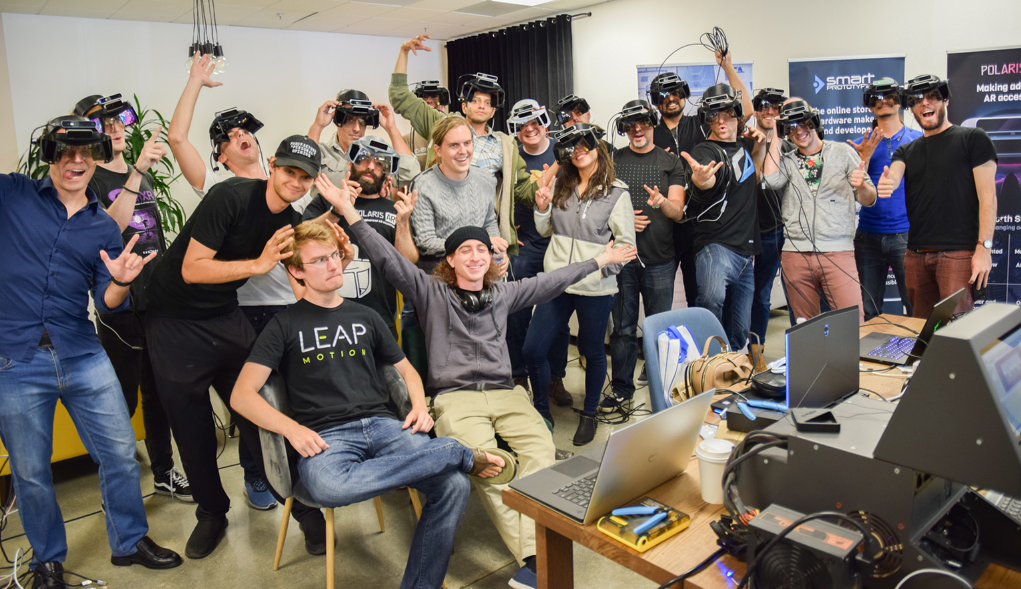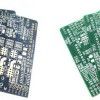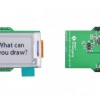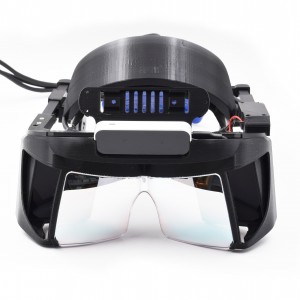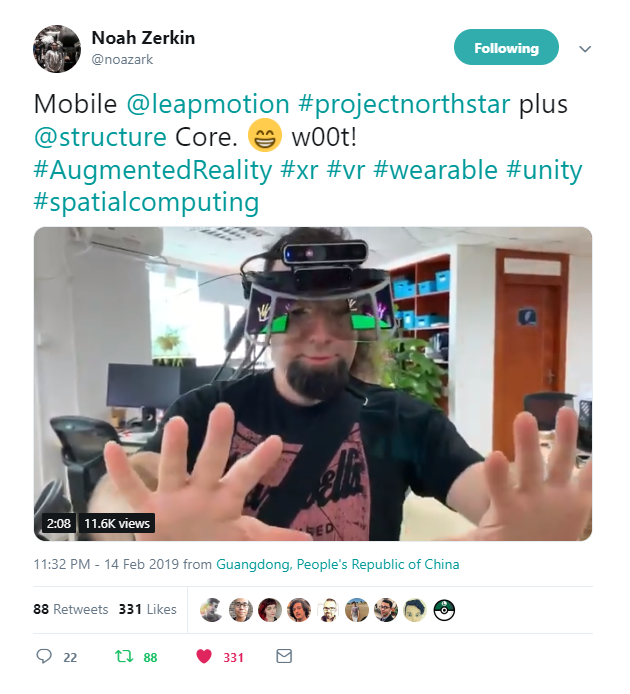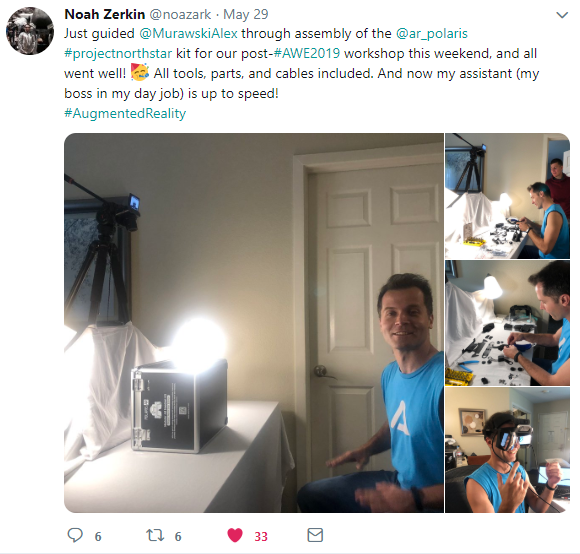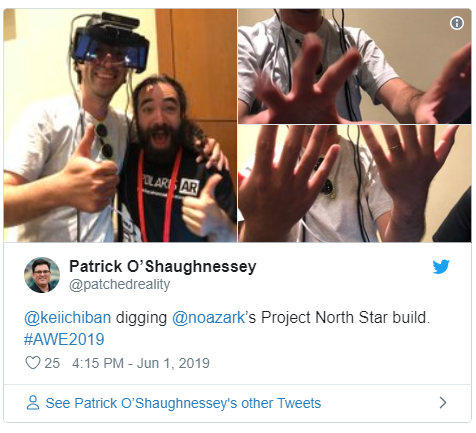#BuildYourNorthStar Workshop Event
During the first couple of days in June, I had the pleasure of co-hosting the first of (hopefully) many Build Your Own North Star workshops. (#BuildYourNorthStar)
First off, I want to thank everyone involved in Project North Star at Leap Motion (past and present) and the folks at Occipital who worked with us on this workshop. Also, I want to thank everyone who attended the workshop, but especially Dillon Morris (@moredillon), who volunteered his time and the use of his professional A/V equipment to help us record and live stream the event! Amazing! I also particularly want to thank Jacob Ervin and Allen Chen from Occipital, and David Holz and the incredible Johnathon Selstad at Leap Motion. This event couldn’t and wouldn’t have been nearly as successful without you.
We produced the workshop under the brand name Polaris AR, in cooperation with Occipital, who make a great 3rd-party tracking/depth camera solution called Structure Core. I’d already integrated Structure Core into my own North Star build and posted videos of it online.
I’ve known the founders of Occipital since 2009, when we met at ISMAR (IEEE International Symposium on Mixed and Augmented Reality). I was really excited when somebody from the company reached out to us with the idea for this event. Since Augmented World Expo was happening in Santa Clara a couple of months from then, we decided that it made sense to hold the event around the same time and place. So we booked Star Space, a coworking space in San Jose, for the weekend after AWE, and set to work planning the event. Incidentally, AWE is one of my favorite events and was created by a few old friends of mine from ARNY, the Augmented Reality New York Meetup, so I’m always happy to have an excuse to attend.
We reached out to Leap Motion ahead of the event, and they graciously offered to supply Leap Motion Controllers for the participants, free of charge! We didn’t, however, nail down the logistics of getting our hands on them.
Fast forward to AWE:
During the first day of AWE, we actually stayed holed up in our hotel suite as I guided Alex through doing his own North Star build. We recorded that process and will release the edited video of that soon. Hopefully, it will be useful for those of you doing your own builds of the kit.

On the second day of AWE, I walk into the Santa Clara Convention Center’s hotel bar for lunch, and there are Keiichi Matsuda (former VP of Design / Creative Director at Leap, who crafted the awesome demos that we’ve all seen… squeeeeeel!) and Angela Bermudo (former Senior Director of Communications at Leap, on whose head North Star was photographed for their press releases) enjoying their meal!
Actually, they recognized the picture of North Star printed on the box I was carrying before I recognized them. I had a bit of a freak-out moment trying to get an unplanned demo running for them. Turns out the driver board in the headset Alex had built is a reworked board from our first production run, and it doesn’t want to work with my new laptop. So I decided to do an on-the-spot display driver transplant from my old uncalibrated headset which I’m also carrying around.
As I’m trying to get this working, Keiichi asks if the source for his demos was ever published, and when I tell him it hasn’t he says “oh, I’ll have to ask David [Holz] if I can do that.”
He says this as David walks past behind them and then notices them. “Well, turn around,” I say.
Keiichi gives me a quizzical look and I’m just like “go on, then.”
Anyhow, we got to witness a totally amazing reunion. And then Thomas Calloway, former Director of Engineering at Leap, walks up out of nowhere. Kind of overwhelming.
On the last day of AWE, Adam Munich, the original initiator of Project North Star, who met David Holz at a party a few years ago and said “hey, we should build an AR headset,” met up with me. After checking out the headset, and being similarly impressed with the most recent version, Alex and I gave Adam one of the PolarisAR kits and invited him to join us at the workshop. We then encountered Johnathon Selstad, current Senior Software Engineer at Leap, and we had a quick chat about some aspects of the project.
Then David messaged me and asked what time the attendees would need the Leap Motion Controllers, and for the address of the space where it would be held. Phew… looked like we were going to get those Controllers after all.
WORKSHOP D-DAY 1:
On the morning of the workshop, Alex, Bence, and I arrived at Star Space to find Dillon already unloading A/V equipment from his station wagon. Dude… if you’re reading this, thanks again!
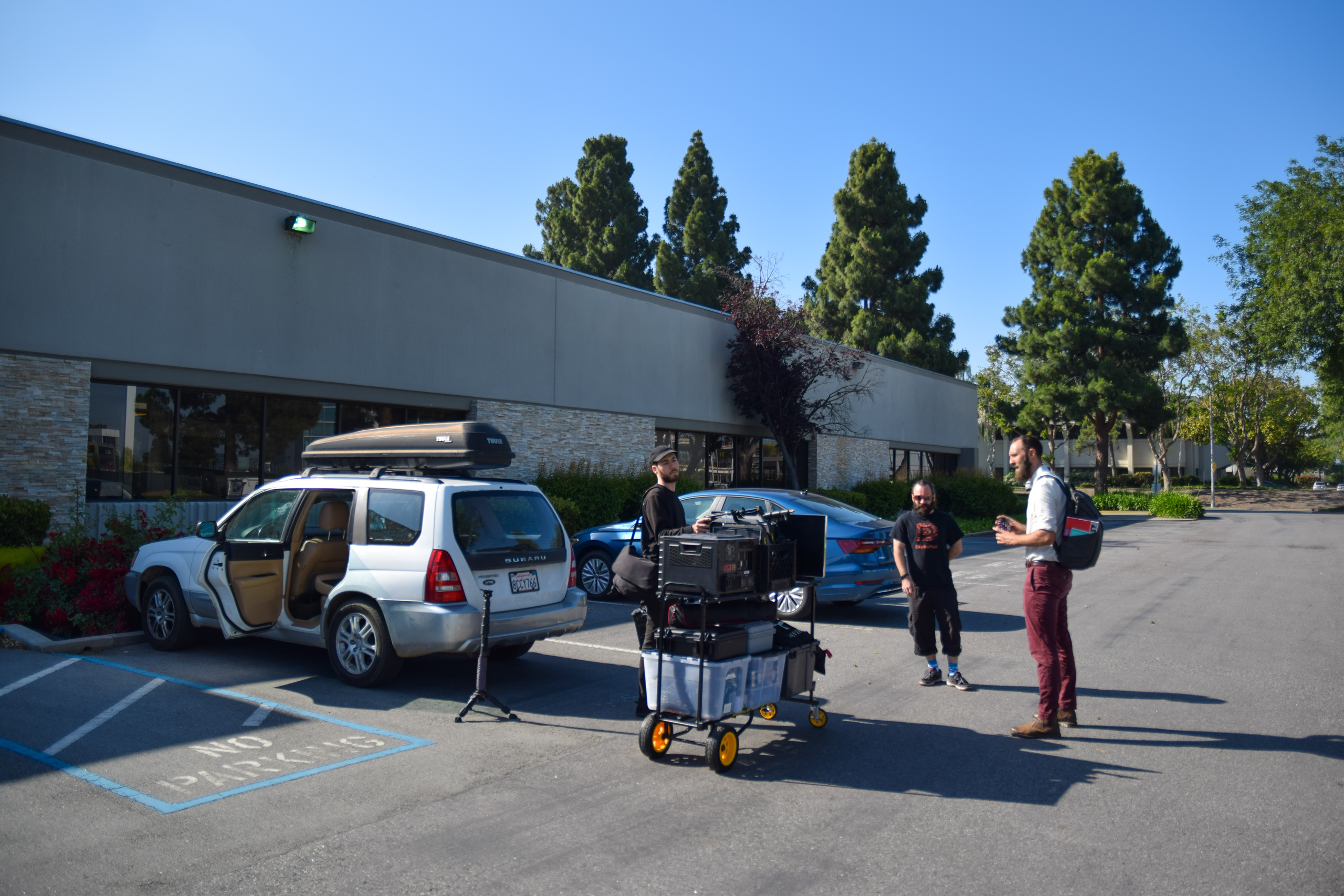
When a staff member arrived and opened the space for us, we brought the equipment in and started setting up. The headset kits, which had been shipped from Shenzhen after we’d headed off to the US, were waiting for us, and we got those unpacked and lined up for people to claim as they arrived. And arrive they did. We had such an amazing group of attendees. Really, I couldn’t have hoped for a better group. We got a little bit of a late start on the first day but got up and running quickly.
First, we got the kits opened up and started unpacking everything. We put the tools off to the side and then unpacked the 3D-printed parts. Step-by-step, we went through doing the initial assembly of the headset’s subassemblies. Some of the parts weren’t printed to perfect tolerances, so we’d included some tools to trim off excess material. Some participants got out ahead of me, having built their own North Star headsets previously, or just because they were already familiar with how things were supposed to fit together.
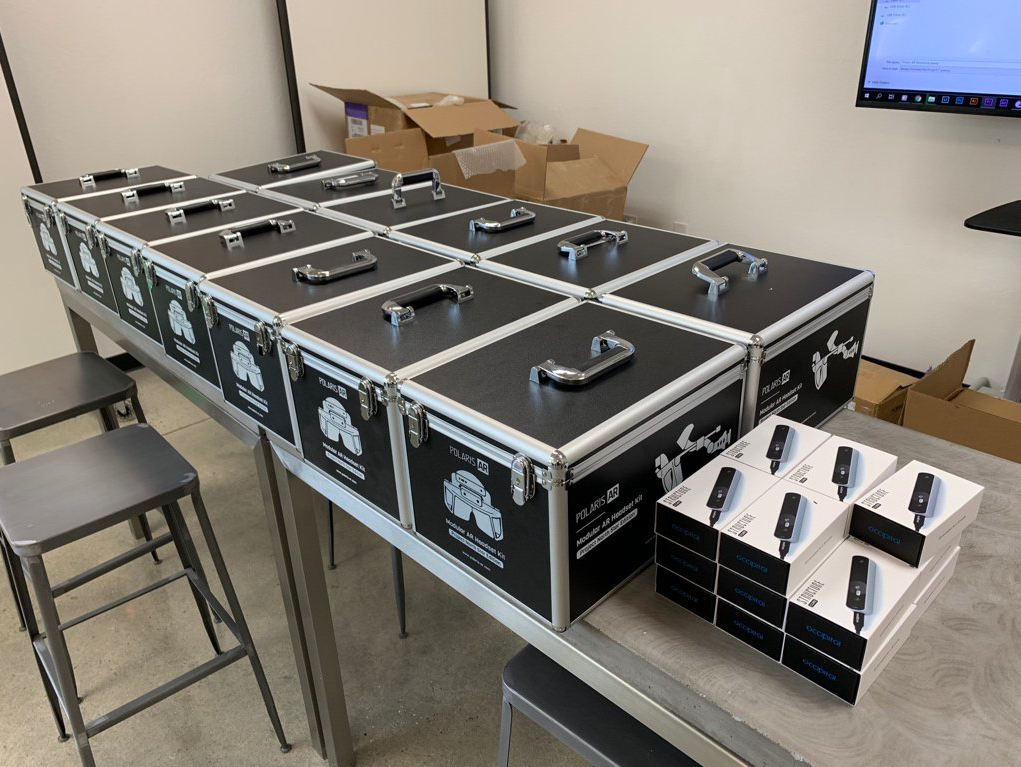
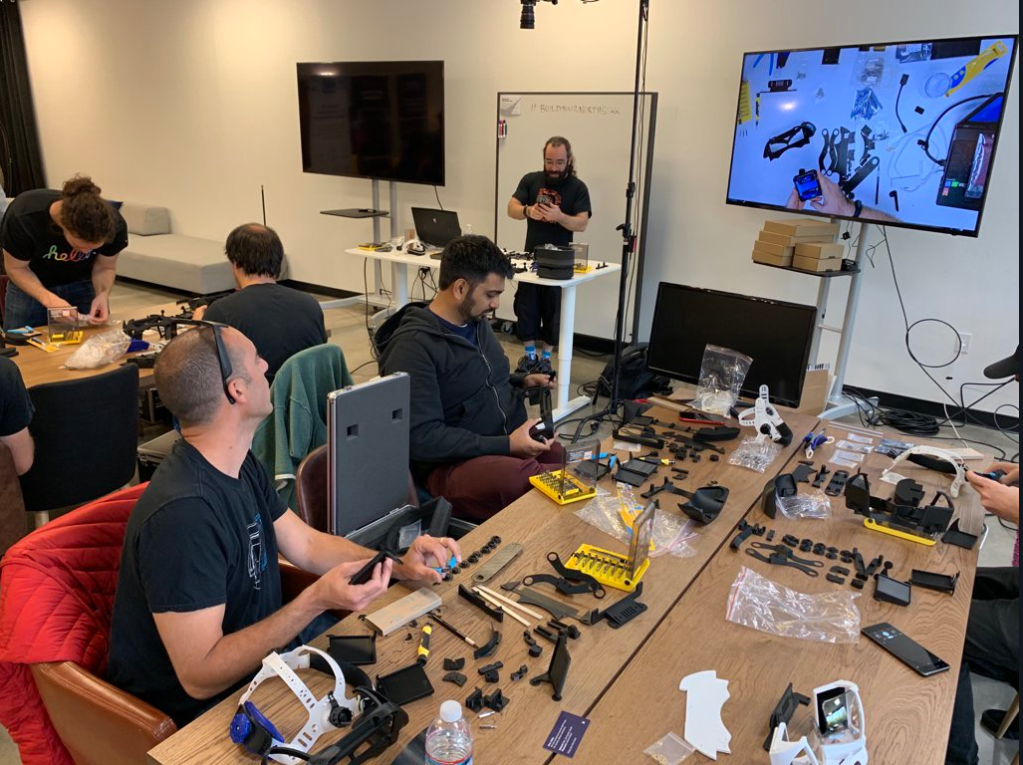
-Photos by @andrewserff
Inevitably, some people tried to force together parts that first needed trimming, and some things got snapped here and there. Well, that’s why we brought spare parts. As people were getting their heat-set threaded inserts installed, and the spring-loaded slide rail mechanisms assembled, lunchtime approached. And then David Holz walked in carrying Leap Motion Controllers for everybody! Pretty freakin’ special. I don’t imagine we can count on that happening at future events.
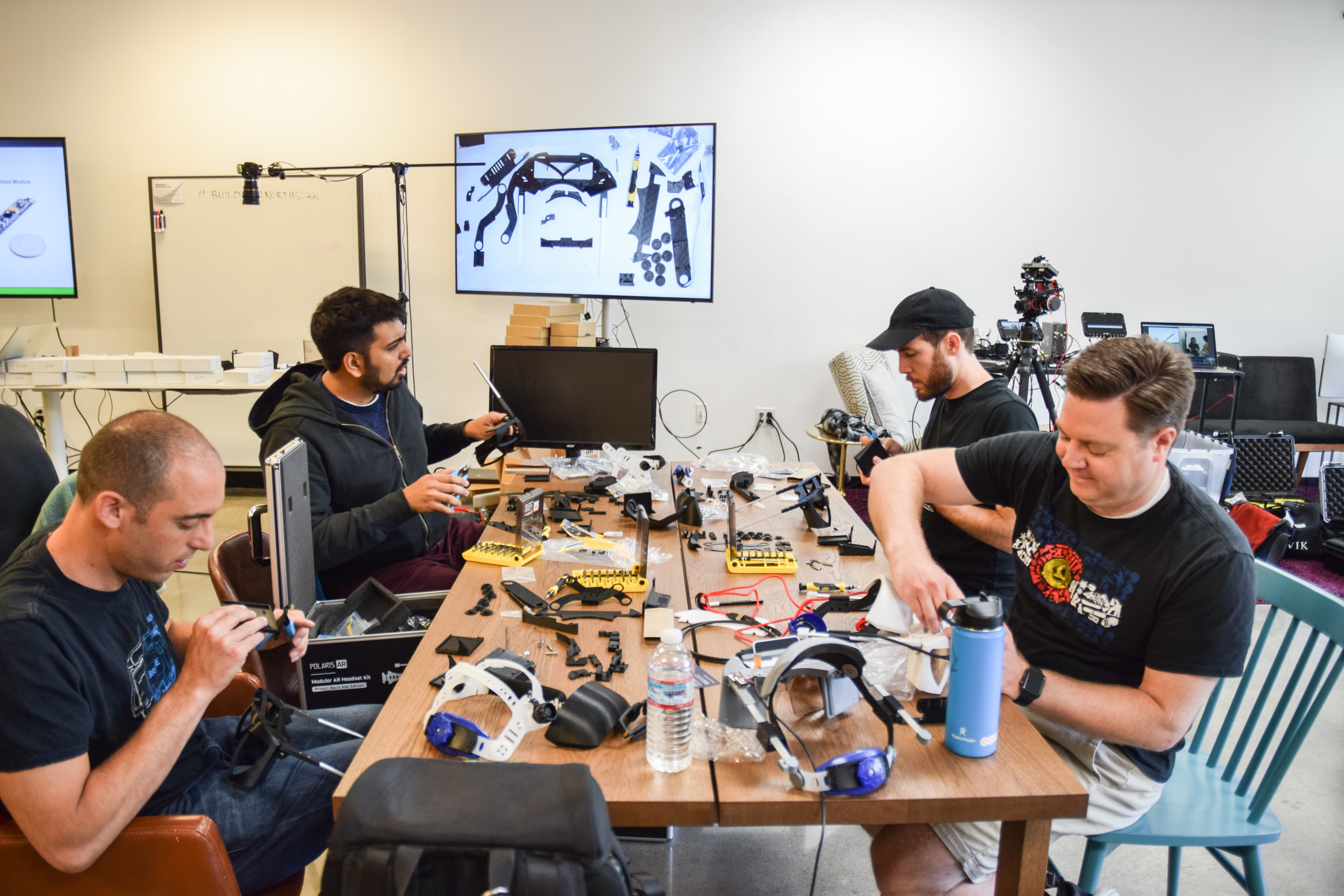
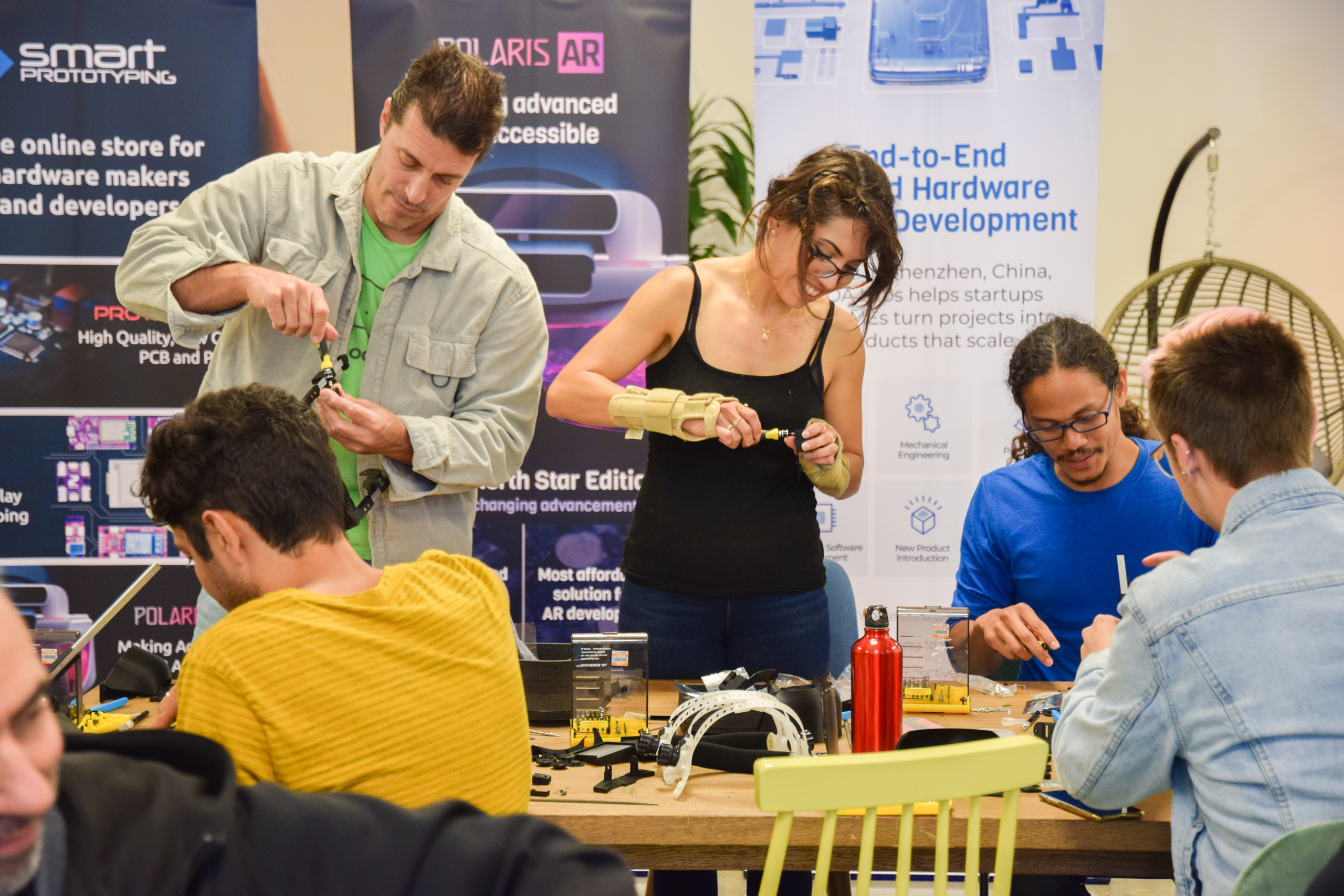
I ceded the podium to David for a while and took the opportunity to check in on everyone and help where I could. At this point, people were supporting each other by sharing knowledge of how the headset should go together, and I just needed to field questions. The kit I’d been assembling at the front of the room ended up being split up for spare parts. Actually, I didn’t end up getting to do my own start-to-finish kit build until a few days after we got back to Shenzhen!
.jpg)
Worth mentioning, we had special sets of lenses coated by a lab in the US on David’s recommendation, and they are incredible. Unfortunately, those coatings also cost a LOT more than what we’re having done here in Shenzhen, but we may have some more made for people who are using North Star in applications where it’s really critical to have the best possible optical quality. David made a point of telling everyone at the workshop how amazing the lenses were, and how they were privileged to have sets of the best North Star combiners in existence. Awesome.
Lunchtime rolled around just after Adam Munich paid us a surprise visit, toting the kit we’d given him the day before. Unsurprisingly, though he showed up halfway through the day without having started assembling the kit, his headset was done and working hours before anyone else’s. We ordered pizza for everyone and hung out and ate for a bit, and then people got back to work on their own. It really was amazing how everybody supported each other, which is kind of a microcosm of the North Star community in general.
As people finished assembling everything except the electronics, I started distributing the displays and display driver boards that I’d been keeping aside so that they didn’t get damaged laying around on the tables.
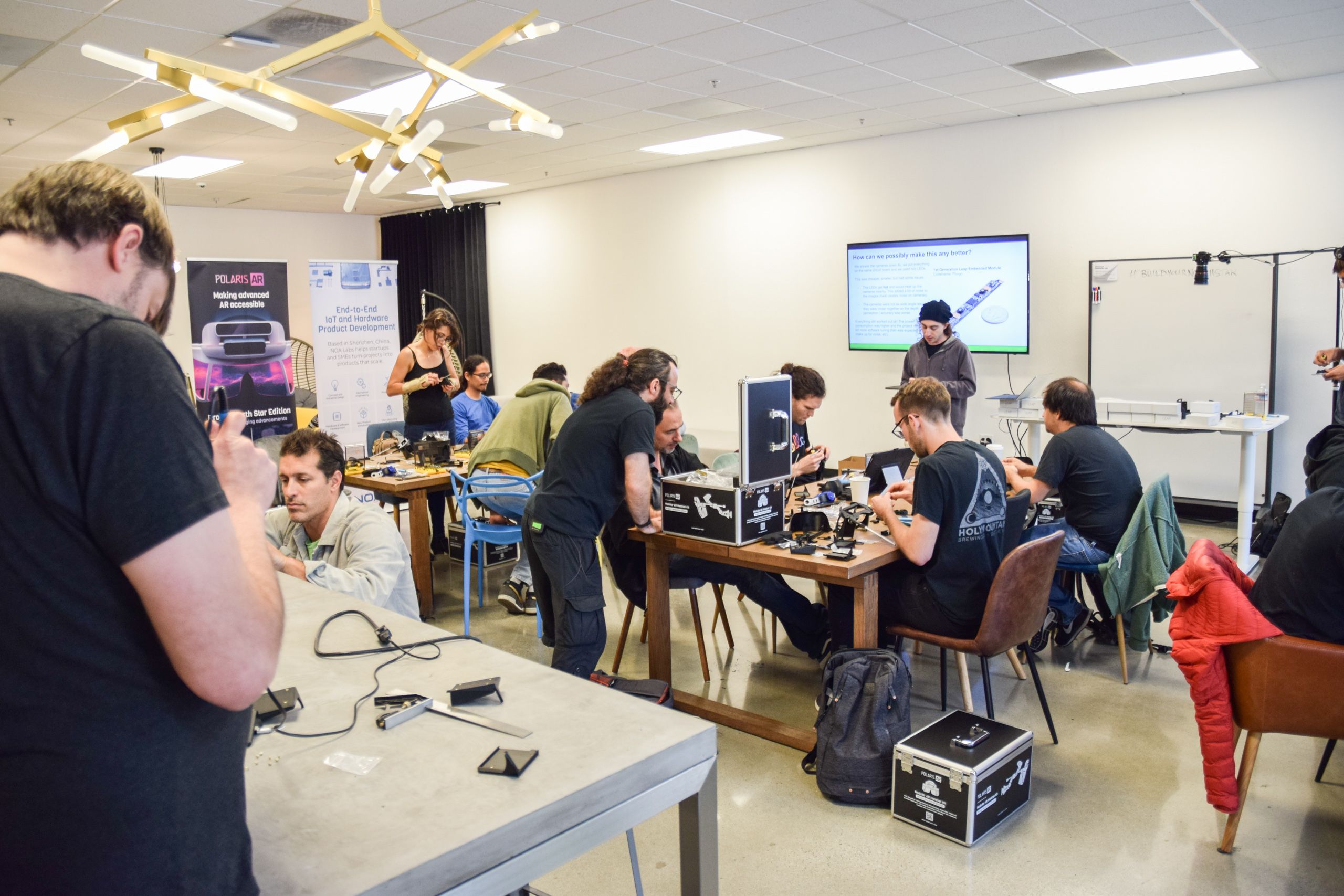
One-by-one, the displays in people’s headsets started lighting up, and by the end of the day, everyone had working electronics. But not everyone had a full-sized DisplayPort to connect to on their computer. I’d brought enough adapters so that everyone could test their headsets at their tables, but that wasn’t going to help with Day 2 when Occipital’s Jacob Ervin would be guiding everyone through getting set up for software development. I was checking to see what adapters people would need so that we could go get them, but once again, a participant stepped up to save the day. Robert Long (@arobertlong), from Mozilla, who was already surveying other participants to see what cables and adapters were missing, volunteered to head to Fry’s and get everything we needed. Epic.
WORKSHOP D-DAY 2:
On the second morning of the workshop, we went around the room and did some quick self-introductions, which we hadn’t gotten to do the day before. I was in the back corner of the room getting the headset calibration system calibrated (yes, the calibration system needs calibration, which takes a lot more work than calibrating the headset once that’s done), while Jacob ran everybody through installing the Occipital Perception Engine SDK, and doing basic integration of their example code and Leap Motion’s.
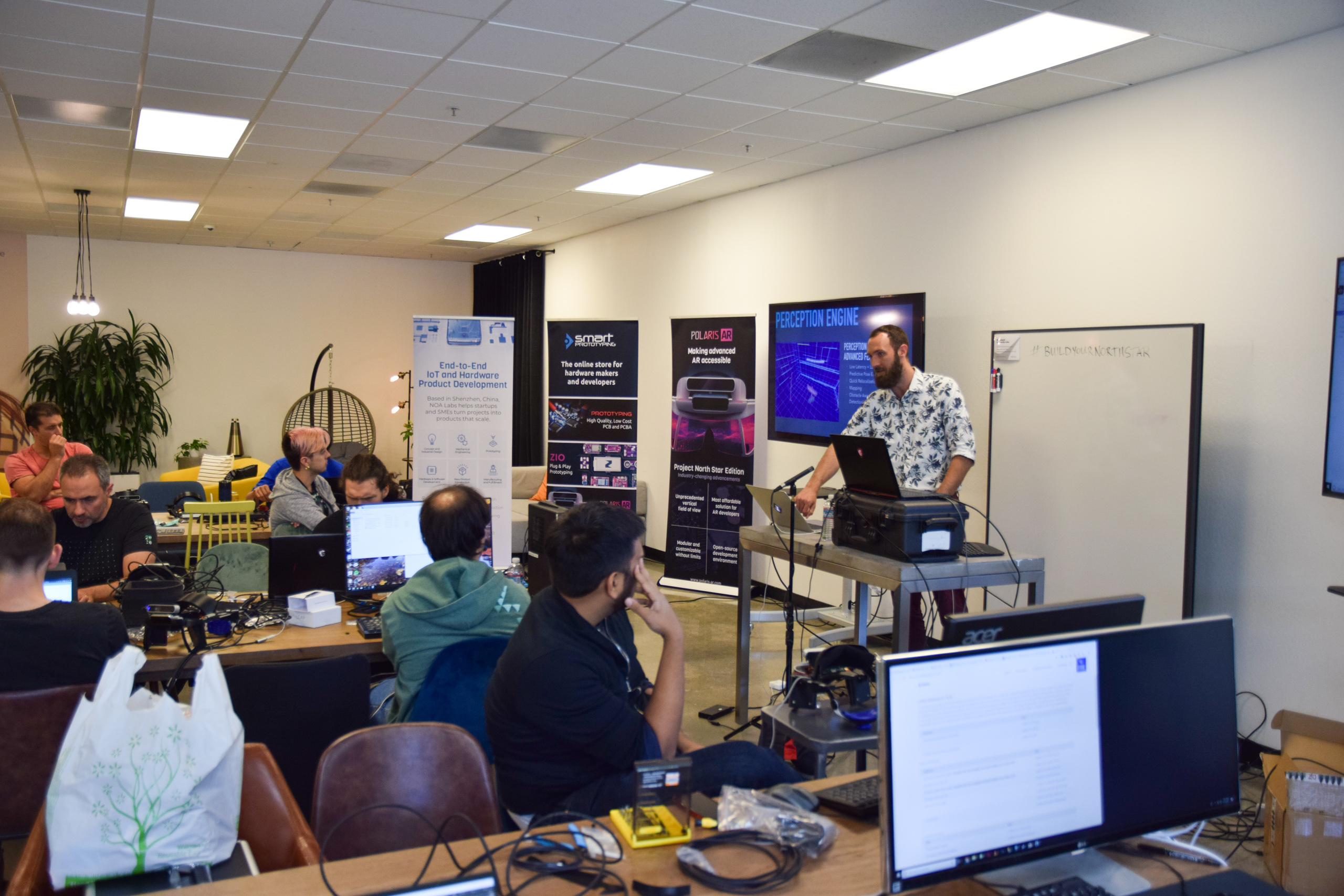
And then David Holz showed up again, this time with Johnathon Selstad in tow! I had three of the four calibration cameras giving good results, but the fourth one just wasn’t locking in as well as the other three. Johnathon asked if I needed any help. I showed him what I had worked, and then he just took over. I was hoping he’d just help me iron out that last kink, but he just took over the role. This guy is a rockstar. I mean… wow. At some point, I was assisting a participant with installing the padding foam in their headset and then turned back to see that Johnathon had put a box over the calibration rig to eliminate stray reflections. We hadn’t even asked him to attend, and yet here he was troubleshooting the process, and then producing calibration files for each and every headset in the room! That’s a lot of headsets. Did he want me to take over once the calibration system was calibrated? Nope. He just took it off my hands.
Really, with so many outstanding people supporting each other, I think the workshop would have gone just as well if I’d decided halfway through the event to run off and go get myself busted trying to sneak into Apple’s R&D labs! ^_^ (Really though… my curiosity has been known to get me into trouble on occasion.)
Also taking a task off my hands was Nader Shokair, who had shown up to the workshop with the craziest looking computer (pulled from the cockpit of his tuned-to-the-point-of-insanity Mazda Miata) and a box full of files. Disambiguation: the kind of files that you use for deburring things, not the kind full of interesting (or boring, as the case may be) information. Since I hadn’t anticipated that the lenses we’d had made would show up with the injection gate material still attached, I hadn’t brought a set of the heated shears that we normally use for trimming off that excess plastic. I was experimenting with using a chisel-tipped soldering iron to do the job on-site and then using Nader’s files to smooth out any warpage in the mounting tabs. Seeing how time-consuming and cumbersome this was, Nader borrowed Dillon’s Dremel and took over the job in a much more efficient manner. As he finished trimming the limited-edition lenses, people installed them and then took them to Johnathon for calibration.
.jpg)
So really, every possible hitch that we ran into got taken care of by one participant or another. And by the end of the workshop, everybody had a working world-class North Star to take home. Thanks to the stellar group of people who chose to join us for this event, it really couldn’t have gone better. I think I ended up learning as much about how to run future incarnations of the event, as participants learned about building a North Star headset.

I really can’t thank everybody enough for making this workshop such an amazing success.
Speaking of which, here at Smart Prototyping I want to thank Alex Murawski, my boss at my NOA Labs day job, Bence Szabo, who designed visual assets for the workshop and came along to help document it, Elliot Lloyd, who handled communications ahead of the event, and who put up with some pretty unfair impatience from me, and Alex Chu (and his team) who runs the Smart Prototyping webshop and has been a total champ at sourcing all of the kit components. Elaine Wu is head of our SCM department, and she and her team have worked really hard to help us make high-quality display driver boards available. And Dylan Li has been indispensable in helping me manage the relationship with the injection molding and coating factories.
I also want to thank Naomi Wu for helping me get set up with a whole bunch of Creality CR-10S Pro 3D printers so that I could print all of the parts for the workshop kits.
I know this sounds like the acknowledgements at the end of an awards speech, but I get thanked A LOT for what I’m supposedly doing for the Project North Star builders’ community. So I want you all to know that, at the end of the day, I’m just a guy who wanted good North Star lenses enough to pay for an injection mold. Thank YOU for being as excited about Project North Star as I am, and for helping me realize my dream of getting to play an active part in something meaningful for the augmented reality industry. Now that we’re finally about to start shipping complete kits and calibrated headsets out to customers, I promise that we’ll keep pushing our hardest to support this amazing community and to make advanced AR research and development hardware available as affordable as we can.
